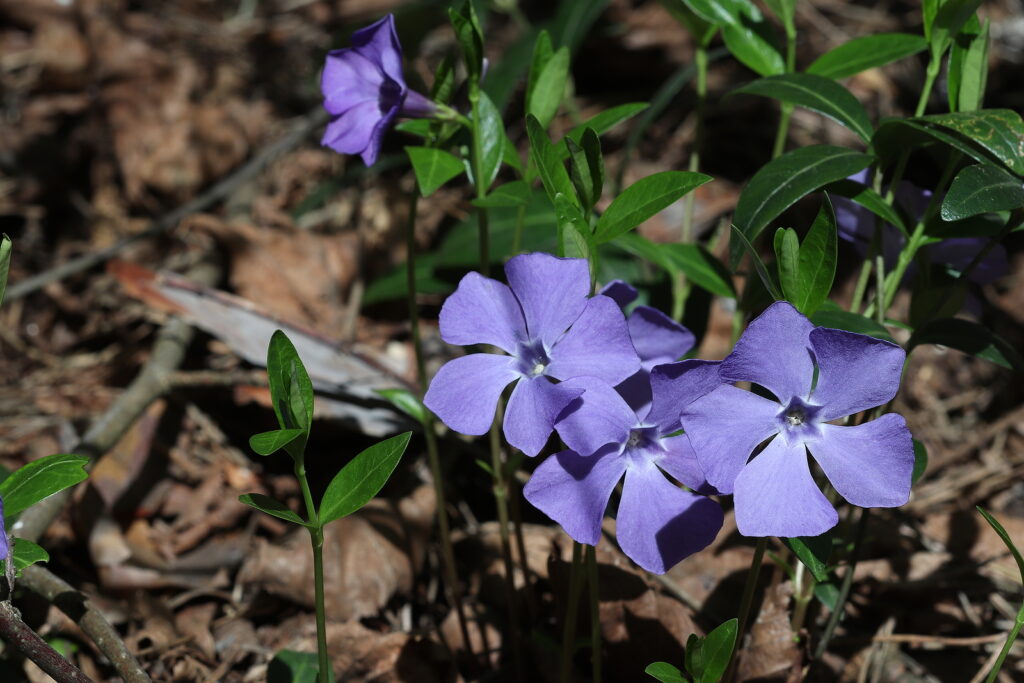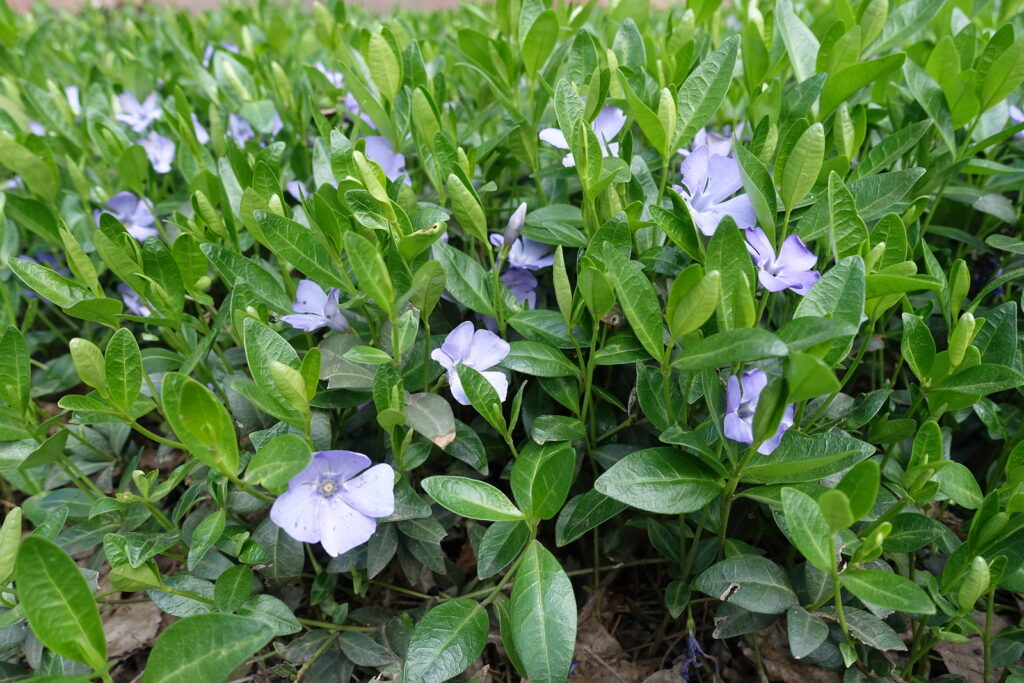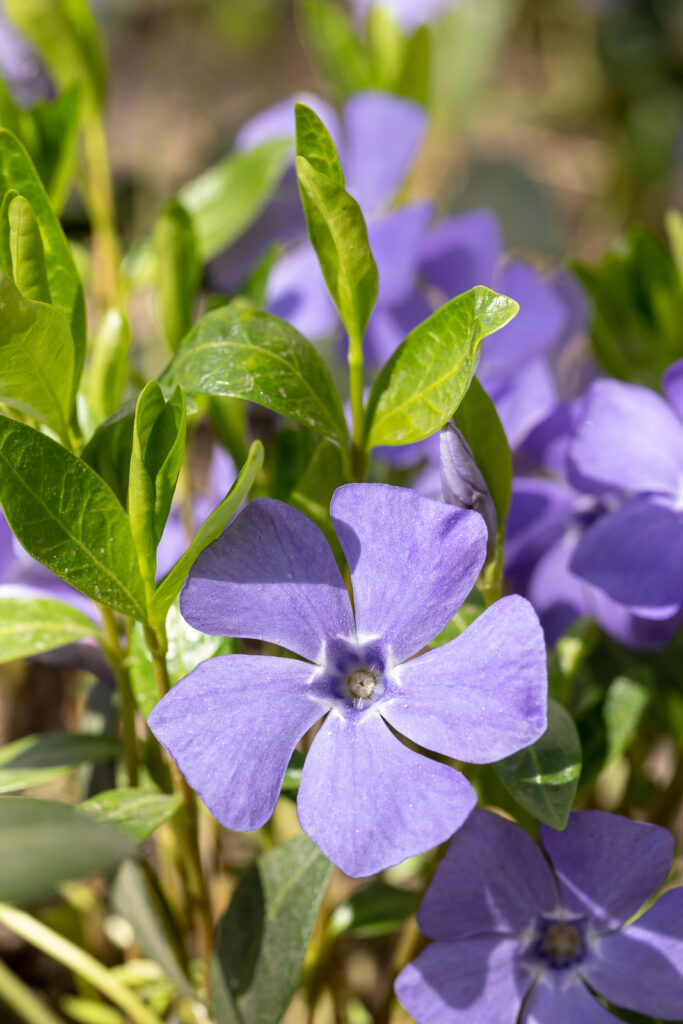Vinca–commonly called periwinkle–are slender stemmed evergreen subshrubs and perennials that bear lavender blue, five-petaled, pinwheel-shaped flowers above shiny dark green oval leaves.
Vinca is a useful ground cover for a woodland garden, shrub border, or shady bank. There are two commonly grown species, Vinca major and Vinca minor. Vinca minor has smaller leaves and flowers and a nearly mat-forming ground cover. Vinca major has larger leaves and grows taller; it can be invasive if left unattended for several months.
There are seven species in the Vinca genus. All grow best where the soil is just moist and where they are shaded from the mid-day sun.
Good Products for Growing Flowers and Shrubs at Amazon:
- Garden Safe Snail and Slug Bait
- Bonide Sulfur Fungicide
- Monterey BT Caterpillar Killer
- Neem Bliss 100-% Cold Pressed Neem Oil
- Safer Brand Insect Killing Soap
- PyGanic Botanical Insecticide

Get to know Vinca
- Plant type: Evergreen perennial
- Growing zones and range: Zones 4 to 9
- Hardiness: Hardy to Zone 7
- Height and width: 12 inches (30cm) tall and 12 to 18 inches (30-45cm) wide.
- Foliage: Shiny, oval, mostly evergreen leaves that are opposite on trailing, arching stems that root where they touch the soil.
- Flowers: Five-petaled, pinwheel-shaped, lavender-blue flowers appear in leaf joints and have a slender tube at the base and an abruptly flared and flattened face.
- Bloom time: Spring.
- Uses: Groundcover and useful along shaded woodland paths.
- Garden companions: Good underplanting for deciduous trees.
- Common name: Periwinkle
- Botanical name: Vinca
- Family name: Apocynaceae
- Origin: Woodlands of Europe, North Africa, and Central Asia
Where to plant Vinca
- Plant Vinca in light shade.
- Vinca in ordinary soil but thrives in sites that are moist and rich in potash.
When to plant Vinca
- Set container-grown Vinca in the garden in spring or autumn.
- Sow seed in spring.

Violet flowers of Vinca minor
Planting and spacing Vinca
- Space Vinca 6 to 18 inches (15-45cm) apart depending on how quickly you want plants to fill in.
- Sow Vinca seed 1/8 inch deep in evenly prepared soil.
How to water and feed Vinca
- Give Vinca moderate water.
- Fertilize Vinca minor in spring with an all-purpose organic fertilizer; Vinca major usually needs little fertilizer.
How to care for Vinca
- To restrict Vinca’s growth cut it back hard in early spring.
- Vinca major can be invasive; it will root when arching stems touch the soil so be careful not to let it go.
Vinca pests and diseases
- Vinca can develop canker, dieback, botrytis blight, and other molds, rot, and yellows.
- Vinca is susceptible to attack by aphids, beetles, and leafhoppers.

Vinca propagation
- Divide Vinca any time during the growing season if kept watered after planting.
- Take Vinca cuttings in summer.
- Dig up small Vinca plants where stems have touched the soil and rooted; replant them immediately.
Vinca varieties to grow
- Vinca major, Greater periwinkle, is the larger, more aggressive species. Good as an annual, trailing, container, or window-box plant in the North, and it is useful as a perennial groundcover in Zones 7 to 11. Leaves to 3 inches (7.6cm) long, flowers to 2 inches (5.1cm) across. It grows 10-18 inches (25.4-45.72cm) tall. Shear close to the ground occasionally to bring on new growth. The cultivar ‘Variegata’ has green leaves with irregular white margins.
- V. minor, Lesser or common periwinkle, with smaller leaves and flowers, has lavender-blue flowers and glossy, green leaves. 8 inches (20.3cm) tall, it grows well in sun in northern climates but does best in shade even there, although it may not bloom as heavily. More restrained, less likely to invade adjacent plantings. Among the many varieties are ‘Alba’, with white flowers; ‘Atropurpurea’, deep purple flowers and small leaves; ‘Aureola’, light blue flowers, yellow veins in leaf centers; ‘Bowles White’ has larger leaves, pinkish buds, and white blooms; ‘Miss Jekyll’, a small grower with white flowers; ‘Multiplex’ has double, bright purple flowers; ‘Ralph Shugert’, white-edged leaves, blue flowers, autumn rebloom; ‘Sterling Silver’ is a blue-flowered form with green leaves speckled with pale green and edged in cream. ‘La Grave’ is similar to (if not the same as) ‘Bowles Variety’. Zones 3 to 9.
Vinca frequently asked questions
Q: How do I start vinca from seed?
A: Sow seeds indoors 12 weeks before the last frost. Cover the seeds completely; they need darkness to germinate. If you wait to start seeds in the garden, the plants will not reach blooming size during the summer.
Q: What kind of conditions does vinca need?
A: Plant vinca in full sun or partial shade in any well-drained soil. Vinca prefers just moist soil but can tolerate drought and heat. Add fertilizer to the soil before planting; no additional fertilizer is needed.
Q: Is there more than one type of vinca?
A: Yes, there are both upright and spreading forms of vinca. ‘Carpet’ and ‘Polka’ are ground cover varieties. Upright forms include the varieties ‘Little Blanche’, ‘Little Bright Eye’, ‘Little Pinkie’, and ‘Little Rosie’.
Related Articles:
- 20 Perennials That Bloom for 6 to 8 Weeks
- Shrubs with Showy Flowers Season-by-Season
- Trees in Garden Design
- Growing Annuals for Summer Bloom
- Trees—click here for more articles
- Shrubs—click here for more articles
- Perennials—click here to see more
- Annuals—click here to see more















